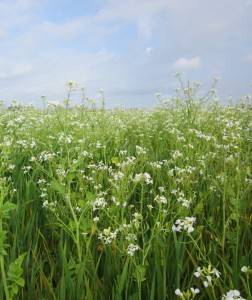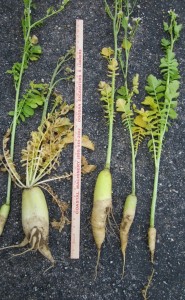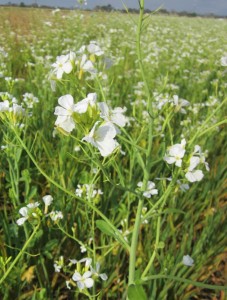
On the corner of US 29 and FL 97 in northern Escambia County, people have been wondering what crop Eric Koehn (local producer), planted in the fields late last Fall after he harvested. The answer is a mixture of “Sodbuster” radish and oats.
According to Richard Petcher, retired Auburn Extension Agronomist agent and proprietor of Petcher Seeds, Sodbuster Brand Radish is a new cover-crop forage-radish developed in New Zealand. The Sodbuster’s large taproots are superior and can penetrate soils as far as 6 feet deep.

The taproot’s fleshy upper part can “bust” a hole from 10-20 inches long and 2-3 inches wide. This radish root plows and breaks the hardpan, and also scavenges for plant nutrients. The root decomposes rapidly when terminated (Petcher says decomposition will occur in 4-6 weeks this time of year and even quicker during warmer weather). The areas where roots decompose form open holes allowing water to infiltrate the soil. According to Petcher, the crop is an excellent scavenger for nutrients and can release as much as 80 pounds of Nitrogen and 5 tons of organic matter for the next crop. Wildlife, especially deer, love this radish.
In November, Eric planted 5 pounds of “Sodbuster” radish seed/acre and added some oats to the mixture. Although he didn’t add apply any fertilizer to the crop, he is satisfied with the stand and hopes to see some benefits in the dryland cotton he intends to plant in these fields later this year.

For more information about where to get “Sodbuster” radish seed, please visit http://www.petcherseeds.com/ . For more information on cover crops in general, please read this UF/IFAS EDIS publication titled “Cover Crops.” As always, for any agricultural or natural resource questions, don’t hesitate to contact your local, friendly Extension agent at the UF IFAS Escambia County Extension office. You can call me at 850-475-5230, drop by the office at 3740 Stefani Road, Cantonment, or send an email to libbiej@ufl.edu.
 0
0
